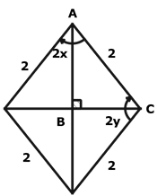CAT Exam > CAT Questions > The sides of a rhombus ABCD measure 2 cm eac...
Start Learning for Free
The sides of a rhombus ABCD measure 2 cm each and the difference between two angles is 90° then the area of the rhombus is
- a)√2 sq. cm
- b)2√2 sq. cm
- c)3√2 sq. cm.
- d)4√2 sq. cm
Correct answer is option 'B'. Can you explain this answer?
Most Upvoted Answer
The sides of a rhombus ABCD measure 2 cm each and the difference betw...
Given:
- The sides of the rhombus ABCD measure 2 cm each.
- The difference between two angles is 90°.
To find:
- The area of the rhombus.
Let's analyze the given information and solve step by step.
1. Understanding the properties of a rhombus:
- A rhombus is a quadrilateral with all sides equal in length.
- Opposite angles in a rhombus are equal.
2. The sides of the rhombus measure 2 cm each:
- This means that all sides of the rhombus are equal in length, which satisfies the property of a rhombus.
3. The difference between two angles is 90°:
- Let's assume that the larger angle is A and the smaller angle is B.
- According to the property of a rhombus, opposite angles are equal. Therefore, angle C is also equal to angle B.
- The difference between angles A and B is 90°, which means that angle A is 90° greater than angle B.
- So, angle A = angle B + 90°.
4. Finding the measure of angle B:
- The sum of all angles in a quadrilateral is 360°.
- In a rhombus, all angles are equal. So, each angle is 360°/4 = 90°.
- Therefore, angle B = 90° - angle A.
5. Substituting the values to find the measure of angle B:
- angle B = 90° - angle A
- angle B = 90° - (angle B + 90°)
- angle B = -angle B
- 2 * angle B = 0
- angle B = 0°
6. Calculating the area of the rhombus:
- The area of a rhombus can be calculated using the formula: Area = (diagonal1 * diagonal2) / 2.
- The diagonals of a rhombus bisect each other at right angles.
- Let's assume that the diagonals of the rhombus ABCD are AC and BD.
- As the diagonals of a rhombus bisect each other at right angles, angle ABD is a right angle.
- Therefore, diagonal AC is the hypotenuse of right-angled triangle ABC.
- The sides of the triangle ABC are 2 cm (side of the rhombus) and 2 cm (half of the diagonal BD).
- Using the Pythagorean theorem, we can find the length of diagonal AC:
AC^2 = AB^2 + BC^2
AC^2 = 2^2 + 2^2
AC^2 = 4 + 4
AC^2 = 8
AC = √8 = 2√2 cm
- Now, we can calculate the area of the rhombus:
Area = (diagonal1 * diagonal2) / 2
Area = (2√2 * 2) / 2
Area = 2√2 sq. cm
Therefore, the correct answer is option B: 2√2 sq. cm.
- The sides of the rhombus ABCD measure 2 cm each.
- The difference between two angles is 90°.
To find:
- The area of the rhombus.
Let's analyze the given information and solve step by step.
1. Understanding the properties of a rhombus:
- A rhombus is a quadrilateral with all sides equal in length.
- Opposite angles in a rhombus are equal.
2. The sides of the rhombus measure 2 cm each:
- This means that all sides of the rhombus are equal in length, which satisfies the property of a rhombus.
3. The difference between two angles is 90°:
- Let's assume that the larger angle is A and the smaller angle is B.
- According to the property of a rhombus, opposite angles are equal. Therefore, angle C is also equal to angle B.
- The difference between angles A and B is 90°, which means that angle A is 90° greater than angle B.
- So, angle A = angle B + 90°.
4. Finding the measure of angle B:
- The sum of all angles in a quadrilateral is 360°.
- In a rhombus, all angles are equal. So, each angle is 360°/4 = 90°.
- Therefore, angle B = 90° - angle A.
5. Substituting the values to find the measure of angle B:
- angle B = 90° - angle A
- angle B = 90° - (angle B + 90°)
- angle B = -angle B
- 2 * angle B = 0
- angle B = 0°
6. Calculating the area of the rhombus:
- The area of a rhombus can be calculated using the formula: Area = (diagonal1 * diagonal2) / 2.
- The diagonals of a rhombus bisect each other at right angles.
- Let's assume that the diagonals of the rhombus ABCD are AC and BD.
- As the diagonals of a rhombus bisect each other at right angles, angle ABD is a right angle.
- Therefore, diagonal AC is the hypotenuse of right-angled triangle ABC.
- The sides of the triangle ABC are 2 cm (side of the rhombus) and 2 cm (half of the diagonal BD).
- Using the Pythagorean theorem, we can find the length of diagonal AC:
AC^2 = AB^2 + BC^2
AC^2 = 2^2 + 2^2
AC^2 = 4 + 4
AC^2 = 8
AC = √8 = 2√2 cm
- Now, we can calculate the area of the rhombus:
Area = (diagonal1 * diagonal2) / 2
Area = (2√2 * 2) / 2
Area = 2√2 sq. cm
Therefore, the correct answer is option B: 2√2 sq. cm.
Free Test
FREE
| Start Free Test |
Community Answer
The sides of a rhombus ABCD measure 2 cm each and the difference betw...

x + y = 90o
It is given that,
2x - 2y = 90o, x - y = 45o
Solving, we get
X = 67.5o and y = 22.5oConsider triangle ABC
BC/Sin X = AB/Sin Y = 2/Sin 90
Therefore, BC = 1.847
AB = 0.765
Area of triangle ABC = ½ (1.847) (0.765) = 0.764
Area of rhombus = 4 X 0.764 = 2.825

|
Explore Courses for CAT exam
|

|
Question Description
The sides of a rhombus ABCD measure 2 cm each and the difference between two angles is 90° then the area of the rhombus isa)√2 sq. cmb)2√2 sq. cmc)3√2 sq. cm.d)4√2 sq. cmCorrect answer is option 'B'. Can you explain this answer? for CAT 2025 is part of CAT preparation. The Question and answers have been prepared according to the CAT exam syllabus. Information about The sides of a rhombus ABCD measure 2 cm each and the difference between two angles is 90° then the area of the rhombus isa)√2 sq. cmb)2√2 sq. cmc)3√2 sq. cm.d)4√2 sq. cmCorrect answer is option 'B'. Can you explain this answer? covers all topics & solutions for CAT 2025 Exam. Find important definitions, questions, meanings, examples, exercises and tests below for The sides of a rhombus ABCD measure 2 cm each and the difference between two angles is 90° then the area of the rhombus isa)√2 sq. cmb)2√2 sq. cmc)3√2 sq. cm.d)4√2 sq. cmCorrect answer is option 'B'. Can you explain this answer?.
The sides of a rhombus ABCD measure 2 cm each and the difference between two angles is 90° then the area of the rhombus isa)√2 sq. cmb)2√2 sq. cmc)3√2 sq. cm.d)4√2 sq. cmCorrect answer is option 'B'. Can you explain this answer? for CAT 2025 is part of CAT preparation. The Question and answers have been prepared according to the CAT exam syllabus. Information about The sides of a rhombus ABCD measure 2 cm each and the difference between two angles is 90° then the area of the rhombus isa)√2 sq. cmb)2√2 sq. cmc)3√2 sq. cm.d)4√2 sq. cmCorrect answer is option 'B'. Can you explain this answer? covers all topics & solutions for CAT 2025 Exam. Find important definitions, questions, meanings, examples, exercises and tests below for The sides of a rhombus ABCD measure 2 cm each and the difference between two angles is 90° then the area of the rhombus isa)√2 sq. cmb)2√2 sq. cmc)3√2 sq. cm.d)4√2 sq. cmCorrect answer is option 'B'. Can you explain this answer?.
Solutions for The sides of a rhombus ABCD measure 2 cm each and the difference between two angles is 90° then the area of the rhombus isa)√2 sq. cmb)2√2 sq. cmc)3√2 sq. cm.d)4√2 sq. cmCorrect answer is option 'B'. Can you explain this answer? in English & in Hindi are available as part of our courses for CAT.
Download more important topics, notes, lectures and mock test series for CAT Exam by signing up for free.
Here you can find the meaning of The sides of a rhombus ABCD measure 2 cm each and the difference between two angles is 90° then the area of the rhombus isa)√2 sq. cmb)2√2 sq. cmc)3√2 sq. cm.d)4√2 sq. cmCorrect answer is option 'B'. Can you explain this answer? defined & explained in the simplest way possible. Besides giving the explanation of
The sides of a rhombus ABCD measure 2 cm each and the difference between two angles is 90° then the area of the rhombus isa)√2 sq. cmb)2√2 sq. cmc)3√2 sq. cm.d)4√2 sq. cmCorrect answer is option 'B'. Can you explain this answer?, a detailed solution for The sides of a rhombus ABCD measure 2 cm each and the difference between two angles is 90° then the area of the rhombus isa)√2 sq. cmb)2√2 sq. cmc)3√2 sq. cm.d)4√2 sq. cmCorrect answer is option 'B'. Can you explain this answer? has been provided alongside types of The sides of a rhombus ABCD measure 2 cm each and the difference between two angles is 90° then the area of the rhombus isa)√2 sq. cmb)2√2 sq. cmc)3√2 sq. cm.d)4√2 sq. cmCorrect answer is option 'B'. Can you explain this answer? theory, EduRev gives you an
ample number of questions to practice The sides of a rhombus ABCD measure 2 cm each and the difference between two angles is 90° then the area of the rhombus isa)√2 sq. cmb)2√2 sq. cmc)3√2 sq. cm.d)4√2 sq. cmCorrect answer is option 'B'. Can you explain this answer? tests, examples and also practice CAT tests.

|
Explore Courses for CAT exam
|

|
Signup for Free!
Signup to see your scores go up within 7 days! Learn & Practice with 1000+ FREE Notes, Videos & Tests.























